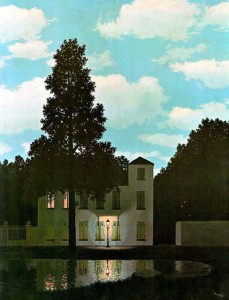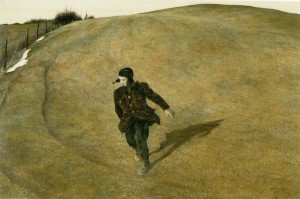It has been well over a year since my last blog post, as I haven’t really got accustomed to putting my thoughts in such a public sphere (assuming of course, that anyone is reading this spiel). I temporarily abandoned Winter 1946 last year after I could not quite gel the story and the narrative together, for it was to be another ‘maximum impact’ comic like The Card Players and needed a very tight composition without superfluous imagery, and so I decided to move on to another painting to see if I could feel more inspired. This has always been a painting that resonated with me because at first glance, the scene seems appealing and yet also very ordinary. An ordinary street at night with a lone glowing streetlamp – already, that itself is loaded with psychoanalytical significance for me and it is an image I return to time and time again in my daydreaming. And that Magritte should make a Surrealist painting of it! But wait… the sky is also bright, it is clearly daytime, but the street is darkened, as if it is night, and the streetlamp is lit. This incongruity perhaps, makes it Surrealist? It is much more subtle than most Surrealist paintings and that may be why I like it so much. I do not know what Magritte intended to make of this picture nor do I know anything about psychoanalysis, but the intrigue and mystery of this painting made me select it for my final story in the set that I intend to publish in a little ‘novella’ sometime this year.
There are no people in this scene, so it is difficult to see at first glance what story one can weave this image into. A Surrealistic story springs to mind, but having things that make no sense in a nonsensical plot is not necessarily a pleasing thing to read. I started working on this story very late in the year 2011, and although I still lacked my early discipline of daily work, I managed to finish more than half by Christmas. I took a break for Christmas and the new year, and then came back, feeling that I had lost direction in my work. But I still had to finish this, so I pushed on and managed to draw the final page just yesterday. 11 pages in total and yet it has felt like an arduous journey.
SPOILER ALERT for what is to follow. The entire story takes place in only a few hours, on a cold and rainy autumnal evening somewhere in Anytown, USA. Carole Bell, our protagonist, leaves work late and goes home much like any other single young woman, choosing to walk in the drizzle instead of riding in a crowded bus. Very early on, we get surreal glimpses and wonder – is this happening in her own mind? On her way home, she encounters gratuitious rudeness from a stranger as well as the desolation of a beggar, inner-city phenomena that we are rather inured to. The steak at the butcher’s seems to speak to her (echoes of another Magritte painting there). She passes a religious billboard several times (the significance of this is to come later). She goes home, where we get the first hint of her real emotional life, waiting for a letter from a lover perhaps? The letter never arrives, and she goes back to her apartment, disappointed. On the way, she meets her neighbour who is wheeling a scarecrow around in a wheelbarrow, like children used to do with effigies of Guy Fawkes. We get the impression that her neighbour is curiously whacked.
She goes home and listens to a voicemail telephone message from her mother, who breezily tells Carole that she and her father have booked tickets for a cruise, “unless Carole wants to go home for Christmas”. We get a further sign of rejection there. Carole is alone in this world, her parents are kind but indifferent and possibly, distant. She faces the prospect of spending a lonely Christmas alone in the city. While cooking her steak for dinner, we are given more context about Carole and her upbringing. Nothing too much is revealed apart from her desire to be alone, preferring the company of imaginary friends to real people who used to mock her throughout a difficult adolescence. We see her with glasses of wine, toasting an imaginary friend in the privacy of her living room, talking to herself and trying to pretend she isn’t as alone as she really is. She falls asleep and wakes up to the smell of burning meat. She chucks the meat in the bin, and ends up eating baked beans while listening to late night radio. I imagine this is an experience we can all relate to…
As she is washing up, suddenly the doorbell rings and she is jarred from her own fantasy existence. This intrusion proves almost too much to bear. She opens the door (another reference to a Magritte, ‘The Son of Man’) and sees her colleague standing there. He is clearly interested in her and uses a limp excuse to come by her place in the evening after work. Their conversation is forced and awkward and he mentions that her ‘weirdo neighbour’ had given him a religious pamphlet on his way in. He then sees two glasses on the coffee table and thinks Carole has company. She lies, in order to make him leave. She wants to be left alone, and yet after she closes the door on him, the silence descends and she feels desperately alone again. She has been rejected, and rejects others herself, to be alone with her ideal fantasy. We start to get the idea that she is… not mad, perhaps, but maybe a little unhinged. How many of us have not preferred imaginary company to some real people? Jesting aside, she goes to clear away the wine glasses and looks at the pamphlet. Again, there is a quote from the Gospel of John, “As long as I am in the world, I am the light of the world.” And the story is called, The Empire of Light. But there isn’t a lot of light in the imagery, instead there are lots of bright lights and shadows, a lot of contrasts. We see Carole in the shadows much of the time. As she begins clearing up the glasses, she starts to speak to her imaginary lover again, but this time rather more beseechingly. The shock of the little interlude with her colleague has clearly unsettled her fantasy. Her lover has not written, they have not shown themselves ever since “that first time”. As she washes the glasses, she has a sinking realisation that her true love is beyond her reach, that she has rejected reality in favour of a chimera. And yet as she readies herself for bedtime, she reminisces, and longs to be back home on the wintry farm, where she woke up one morning and saw a figure of someone wandering across the snow. Man or woman, we do not even know. It was this quotidian image that struck her, and she promised to herself that she would “remember it forever”. That person was her true love, or at least, represented her notion of her true love. Perhaps that extent of fantasising is scarcely believeable, particularly because we do not know if Carole had even seen its face, or had any other reason for developing a sudden romantic fixation. Does this stretch credibility too far?
At any rate, she goes to her bedroom, sets her digital alarm clock (which hasn’t melted) and the reality of her loneliness hits her full in the face. She must bear the burden of her isolation and loneliness (which in a way, she has chosen for herself), and she breaks down and cries… but then her windows seem to give off light, she goes to the window to see what is going on, and there the Magritte painting of the title is introduced. Suddenly there is daylight, despite it being late at night. She stands there watching for a long time and feels she has seen a vision. There is no human accessory to Carole’s epiphany-of-sorts, it is entirely supernatural. It may be linked to John 9:5 “I am the light of the world”. She may have come away with a religious experience, or nothing at all, it is up to the reader to interpret. One might think that she is quite completely mad. It is open to interpretation but I do not know if I have left the reader with enough cues to make up their mind. Carole clearly feels re-enervated by what she has seen.
In this story I wanted to explore the nature of paradoxes, and how we sometimes act in a way that goes against our own wants and needs – in Carole’s quest for intimacy, she repudiates the only person (her colleague) who offers her some attention and kindness. Instead she turns towards imaginary figures to fulfil her deepest desires. Have I succeeded in conveying this? The ending and composition of the story is not as tight as in some of the earlier ones, it is a difficult theme to explore in comic form and I do not feel comfortable composing a narrative in the third person, and linking it with the imagery. I did enjoy drawing the frames though, much more than in previous stories. I think this is a style I shall stick to.
So the story is done. I would be interested to know your thoughts, as always, dear Reader.


Recent Comments